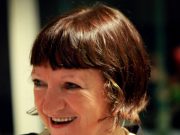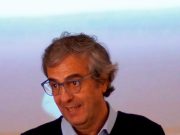BERLINO – Born in Hungary, Tamas trained first as a gymnast and then continued on to the National Ballet Academy. After nine years of classical Ballet training he first joined the Kibbutz Contemporary Dance Company. Following he’s worked with Jan Fabre and from there he joined the Ballett Frankfurt upon the invitation of William Forsythe and became a long time member of his seminal Ballett Frankfurt. In recent years, he’s taught in many of today’s best Dance Institutions, the Palucca Hochschule in Dresden, the Boston Conservatory of Music and Performing Arts, the Royal Academy of Antwerp, P.A.R.T.S Bruxelles, Codarts Rotterdam, the DANCE Apprentice Program, the Arsenale della Danza at theVenice Biennale , Tokyo ArchiTanz, the Korean National University of the Arts, the Frankfurter Hochschule, etc. Ha also gave company classes at such companies as the Cullberg Ballett, Ballet Preljocaj and others.
When did you come in contact with dance for the first time?
I think the first time was probably either with a movie or a television show. But then to really come into contact with it was only during dance school. Before that I did gymnastics and springboard diving in the city where I lived.
Where did you live?
I lived in a small town, called Esztergom which was the old capital of Hungary.
When I was 7 my mom sent me to practice gymnastics, but I was too weak and too little to do it properly. So I usually just hang out at the wrong side of the room, and learned how to stretch with the girls. After our trainer passed away suddenly, there was nothing else to do for sports in Esztergom and I had still way too much energy at home. It drove my mother crazy that I couldn’t sit quietly and my legs were all over while watching TV. So when I was about ten, she saw an advertisement for the National Ballet school. To be honest, the main attraction for me was that the school was in Budapest. I had not yet seen a live dance performance, so I never knew being a dancer was a profession. The image of a dancer for me was a girl, mid air, jumping in a split. Since I could do the split, this was all completely clear with me, I could go and dance ! I only asked my mother: Do boys do this? She said: yes, yes of course, men dance also. So I though… I’m set… without knowing at all what I was getting into.
We went to the audition, and I guess because I was flexible and I had a good ear ( I also studied music in my school ) , they took me immediately. However, when I looked around also understood: This is a big deal, there are a LOT of kids here who want to do this so I better pay attention. That year there were around a thousand children auditioning on the first day. The school admitted only 36. So that’s how I actually got into dance.
What is it that prompted you to pursue this passion and to make it such an important part of your life?
As I said, I never before had the idea: “Oh I want to be a dancer”, for me this was more of an opportunity to get away from home. Dance seemed to be something I had an ease of learning. Sort of… I loved to be physical, to move, I was fairly well coordinated and I could learn pretty quick, but I was certainly not the best in my class. Yet I understood innately that I could do this pretty well. So Instead of a big passion to dance, at the beginnings my main drive came from the periodic selections at school. At the start there were the 36 of us, but every half a year there was a selection Exam, so if you weren’t good enough they would send you home. By the time my class finished the whole nine years course, there was only 4 of us left from the original 36. So during these training years it was very important for me not to be kicked out. That was my main drive. .. later on, it was to prove it to myself that I can do better than the people who were favored over me. The school made it very clear that I would never be the lead in Swan Lake. So immediately I started to look for other things apart from ballett. I loved pop music and that kind of creativity. That seemd much more what I identified with, although I also came to understand and appreciated the beauty of classical ballett. So my love for dance grew slowly. My main passion was towards the visual beauty, the poesy in some performances, then performing, becoming an independent and individual artist. It made me immediately open to learn just about anything, Modern, Jazz or anything I could be part of. In my summer holidays I did Musicals to earn some extra money.
What are the most beautiful experiences and the greatest satisfaction that dancing has given to you?
The most beautiful experience, I think, is the fact that I ended up working at the highest level of art creating with Forsythe. I got invited by him into an environment where creative freedom was incredibly well supported. i never experienced that before. Working with Bill was a real eye opening time in my life, where there was an incredible freedom for us to be individual, to fool around, to be ourselves, to be silly in rehearsals and to articulate qualities that hadn’t been articulated in the field of dance. He’s allowed us to be self sufficient and creative. A lot of original ideas came out from us playing, dancing and fooling around. It was incredible fun to be part of this kind of environment, and to see that the result was, that with Bills overview we created very inspiring balletts. It was an exceptional opportunity in my life. Of course I could also list names of incredible people I’ve met and the places we’ve performed at… I remember sitting in Milano at the Scala in the old dressing room of Maria Callas ( which I think is now gone since the renovations ) getting ready to perform and thinking … “If my mom and friends could see me now” … The greatest satisfaction I guess , is that I gained a clearer understanding of myself through dance, I learned how to define my authentic talent and got to make the most of it.
About Forsythe, what do you think about Godani replacing Forsythe?
Jacopo is not really a surprising choice, he’s been part of the company for many years… if Bill is ready to retire and the company is continuing… I suppose he’s the person Bill trusts the most to take the reins. I’m sad to hear Bill is retiring. He’s truly an inspiration at work. I watched him a few weeks ago in rehearsal and he still charges up the room. He really has a masterful eye. I hope he will stay around and keep close contact with the dancers.
When I attended your workshop I was impressed by the great research on understanding movement. Why is this important to you?
The main aspect of any dance training ( regardless of style ) is to enable a dancer to use their body to present form, flow, artistic grace and vision on command. The method of training I present is a way of recognizing and making use of the body’s natural sense of movement (and coordination) and to create a clear flow of focus while dancing. Seeing dance this way is then helpful to retain form yet allowing freedom of movement to take it’s place. There is importance of keeping rigor and clarity in any dance form ( ie, classical, modern, contemporary or standard dance styles ) but it has to be paired with freedom of creativity. So I aim to help my students in attaining a clear state of falling into movement and letting “happy accidents” or happenstances come forth while retaining an elegance of form. This leads to articulating an authentic sense of movement, creativity and exploring the unfamiliar. This is at the beginning of any true artistic process.
Which direction is dance taking?
There are many different directions thriving. I see a great new way of seeing story balletts, for example in the works of Stijn Celis’s. I find the works of Sidi Larbi very good. There is huge audience success with the hip hop balletts. It’s all good stuff… this is where contemporary dance is… sprouting a lot of new seeds. I love the use of movement in the theatre works of Jan Fabre, Robert Wilson and Peter Sellars. But, In recent years there has not been singularly strong, visionary personalities like Forsythe or Pina Baush that inspire a whole generation of dance trends. There are a lot good choreographers with impressive works, but no one with that type of strong independent vision. But someone will emerge on the scene eventually, I’m sure.
In which direction is Tamas going?
Luckily I have different opportunities during my teaching and choreographic works these days. In both I persue true and authentic excellence. I understood how to bring it forth while working with Forsythe, where I also had to define myself in my dancing.
My classical training gave me strength and support and Forsythe’s world gave me freedom and inspiration. So, I bring this knowledge together, bring it further, and offer it to people, dancers as well as actors and anyone interested to learn about it. This is also my entry into the choreographic and creative process. First, I lead people to understand what they are naturally and inherently good at, then helped them to articulate it better, and then we can work on the choreographic process as well as what I’m communicating as an artist. So this is definitely the direction I’m moving towards, creating more dance, helping dancers become excellent dancers and perhaps eventually founding my own group.
Nicola Campanelli














































